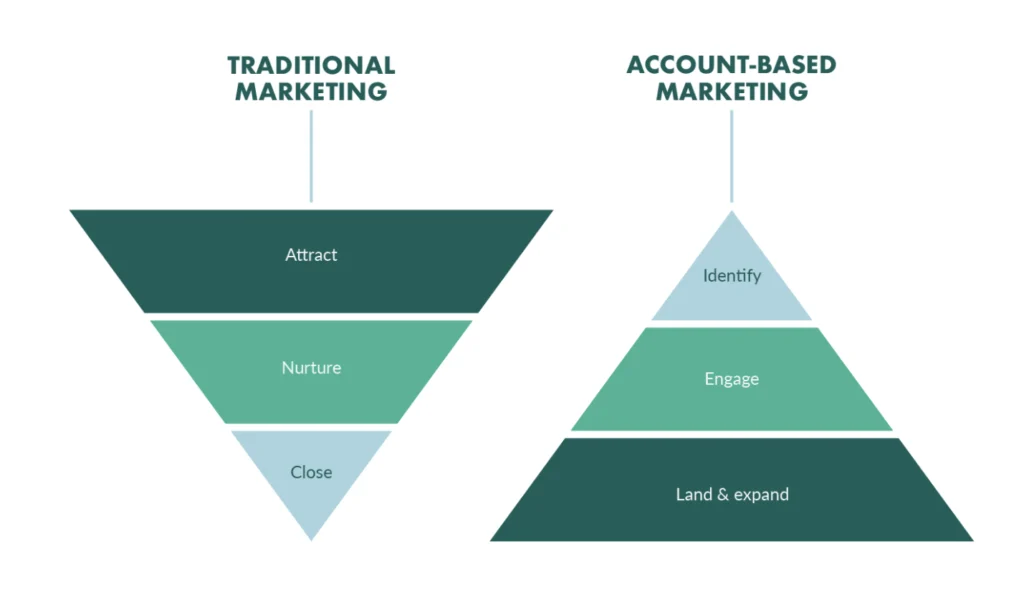How Account-Based Marketing and Sales Work Together
Most sales tactics work like an open house: you send out a mass invitation for everyone to come to your event. However, account-based marketing (ABM) is like an exclusive event that only a select few can attend. In B2B marketing, exclusive marketing through ABM saves you resources as you can focus on a few accounts that are most likely to purchase from your brand.
Explore how to use account-based marketing in your sales strategy to increase your revenue.
Key Takeaways:
- Account-based marketing targets your high-value leads through customized content and relationship building
- You must align your marketing and sales teams to build a successful ABM strategy
- Focusing on quality leads rather than general sales tactics increases your conversion rate
What Is Account-Based Marketing?
Account-based marketing (ABM) is a B2B strategy that focuses on a few high-value accounts rather than general sales tactics. It’s built around relationship-building rather than quick conversions. If done successfully, ABM results in more loyal customers.
While only 22% of companies have an account-based marketing strategy, 34% plan to add one in the future.
For ABM to succeed, you must create personalized content and strategies for each account. This builds trust between you and your lead and eventually encourages them to purchase from you. Taking the time to invest in their experience also opens the door to cross-selling and upselling opportunities.
Why B2B Companies Use ABM
Account-based marketing works best when selling to larger businesses that make more significant purchases. These high-value purchases ensure the return from your personalized marketing is greater than your investment.
You create a customized journey through ABM by targeting, nurturing, and converting account individually. This process saves you valuable time and resources because you only focus on quality leads and don’t waste time on weak and low-value leads.
About 91% of ABM marketers saw more significant deals from these accounts.

Image from SuperOffice
How to Use Account-Based Marketing to Increase Your Sales
Use these seven strategies to build a high-converting account-based marketing strategy.
1. Align Your Sales and Marketing Teams
Account-based marketing is primarily a marketing strategy, with 28% of marketing teams managing their ABM strategies. However, it requires a close alignment of your marketing and sales teams to create a smoother transition from nurturing and relationship-building to conversion.
Successful ABM businesses use a combination of their sales and marketing teams to manage their account-based marketing efforts.

Image from Ascend2
This alignment is also essential for sharing data between departments. For example, while marketing might know what types of content brings in leads, your sales department understands customer pain points and conversion factors necessary for sales. Marketers should use that sales data from the start to create a more personalized journey that takes those pain points and needs into account from the first point of contact.
2. Create a Targeted Accounts List
Your target accounts are what will guide your account-based marketing efforts. These accounts are B2B decision-makers with a high buyer’s intent.
You can create your list of targeted accounts through inbound marketing techniques and account-based marketing lead generation. As you generate B2B leads and qualify them, move the highest value leads to a separate list. However, before you can separate high-value leads, you must first create buyer personas that outline ideal target buyers, including:
- Demographics
- Budget
- Industry
- Job title
In addition to your current leads, you can also find target accounts through research. Using your buyer persona as guidance, research specific businesses that could use your products and services or who currently have a need you could fill.
Even though those businesses haven’t expressed interest in your brand, you can add them to your target accounts list and reach out to them to turn them into a lead for further nurturing.
Over half of marketers target fewer than 1,000 accounts in one campaign to ensure they can provide a personalized experience for each one.
3. Get to Know Your Accounts
If you treat your accounts like a number, your efforts won’t end in sales. Relationship building is an essential component of account-based marketing. To build a relationship with the people behind your accounts, you must get to know them and their needs.
Collect customer data through surveys, personal interactions, and online research. Use this account-based marketing data to learn about key decision-makers within the company, what products they are already using, possible challenges they face, and needs they are looking to fill.
4. Group Your Targeted Accounts
Using the data you collected on your target accounts, sort them into groups based on key factors like the decision-maker, where they are in the buyer’s journey, and their industry. As you send out your marketing content, you can customize your message for each group.
One account-based marketing example is target accounts with financial officers as a key decision-maker who might require content that heavily focuses on costs and revenue rather than end-users who are concerned about how the product helps them perform their job.
5. Use a Variety of Sales Channels
Account-based marketing works across any channel that you can use to provide a personalized experience. About 68% of marketers use digital advertising in their ABM campaigns. Digital advertising includes blog posts, social media posts, and guest posts.
Other popular channels include:
- Virtual events
- Direct mail
- In-person events
- Gifts
- Custom landing pages
6. Measure Your Success
Most marketers use ROI as a key metric for measuring the success of their ABM strategies. In addition, about 97% of marketers say ABM yields higher returns than other marketing strategies.
Understanding how your ABM strategies performed tells you whether your investment is worth the return. If your accounts don’t buy products from your brand, you’re wasting valuable time investing in relationship building.
Mapping their journey is one way to measure your success and see where you can improve. Your target account’s map shows what content or channels they engaged with, and which tactics yielded the best results. You can use that data to streamline your subsequent ABM campaigns. However, it can also tell you where target accounts abandoned their journey, which helps you identify potential issues in your processes.
Bring in More Revenue Through an Innovative ABM Strategy
Increase your sales by adding account-based marketing to your lineup of essential marketing strategies. You can create targeted processes that yield high returns and new opportunities for cross-selling and upselling through ABM. Contact us to learn how we can help you build an ABM strategy that leads to more sales.


